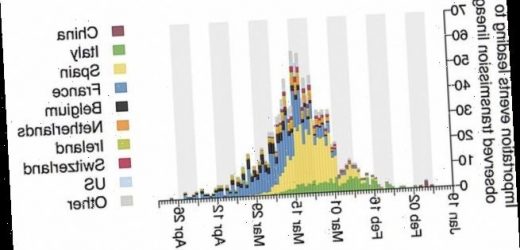Coronavirus was introduced to the UK more than 1,000 TIMES in early 2020 with the majority of transmissions traced back to Spain, France and Italy
- Oxford scientists studied the coronavirus genome of more than 50,000 samples
- Found more than 1,000 introduction events in the UK before June 26 2020
- A third came via travel from Spain, 29% from France and 12% from Italy
- Experts add quarantine and curbing international travel may have helped rein in the amount of new cases and curb spread of Covid-19
Coronavirus came to the UK more than 1,000 times during the UK’s first wave of coronavirus, in the Spring of 2020.
Each event created its own ‘lineage’, as it was passed from an infected traveller coming from overseas to others inside the UK, increasing the spread of Covid-19.
Analysis of more than 50,000 SARS-CoV-2 genomes revealed only 0.4 per cent of cases came from China, ground-zero for the coronavirus pandemic which emerged in Wuhan in 2019.
Popular holiday destinations for Britons were the worst offenders for infection events, with a third of all events coming from Spain, 29 per cent from France and Italy accounting for one in eight (12 per cent).
Popular holiday destinations for Britons were the worst offenders for introduction events in the first wave, with a third of all events coming in from Spain, and 29 per cent from France with Italy accounting for 12 per cent of introduction events (pictured)
Based on the findings, published today in the journal Science, University of Oxford researchers said imposing travel and quarantine interventions earlier in the pandemic could have helped reduce the intensity of the UK’s first wave of cases.
The UK Government has only this week announced a requirement for travellers coming to the UK to register a negative test, ten months after Britain registered its first Covid-19 positive test on February 23, 2020.
More than half of the genomes in the study came from the UK-based COVID-19 Genomics UK (COG-UK) consortium.
By studying the individual genomes of viruses, researchers were able to piece together a week-by-week picture to explain how specific lineages were spreading.
Professor Oliver Pybus, from the University of Oxford’s Department of Zoology and the Oxford Martin School, who is co-lead author on the study, said: ‘This study shows that it’s possible to trace individual virus transmission lineages accurately through time and space.
‘Undertaking analyses on a weekly basis means that genomic tracking can become a key component of public health surveillance.’
People drank more alcohol, ate less fruit and vegetables, and took less exercise during the UK’s first lockdown in March 2020, according to research.
The study by the University of East Anglia suggests that young people, women and those who are overweight were most likely to adopt unhealthy behaviours.
More than 1,000 participants signed up to a daily lifestyle survey in April last year and answered questions for three months which provided the data.
Analysis indicated people drank more alcohol than normal across the board, with women consuming on a more regular basis and men tending to binge drink.
People also had a more lax diet, the study found, with the average person consuming one portion less of fruit and veg per day during the lockdown.
There was a drop of a fifth in the number of days where participants were doing 30 minutes or more moderate to vigorous physical activity, the researchers found.
The researchers said that their work offers ‘a never-before-seen level of insight into the origins and behaviour of transmission chains since the start of the pandemic’.
They said that high travel volumes and few restrictions on international arrivals before the March 2020 lockdown ‘led to the establishment and co-circulation of more than 1,000 identifiable UK transmission lineages’.
The study found the first lockdown, imposed on March 23, 2020 when the UK had registered 2,323 total cases, was somewhat effective at snuffing out some lineages.
However, it was only able to eradicate lineages which had yet to become widespread. The delay in introducing lockdown initially allowed some lineages to grow so big that the draconian measures were unable to squash them.
The team said this ‘contributed to accelerated epidemic growth that quickly exceeded national contact tracing capacity’.
Their findings published today used data up until June 26, 2020, before the mutated and highly infectious Kent strain, also known as B.1.1.7, emerged.
This new variant now accounts for 61 per cent of all cases in England as the pandemic continues to spiral out of control.
But the researchers believe their technique and method will be of use in monitoring the spread of the variant and will help understand why and where B.1.1.7 is spreading so quickly.
Co-lead author Louis du Plessis, a postdoctoral researcher at Oxford’s Department of Zoology, said: ‘Our work offers unparalleled views into what’s happening in an individual epidemic.
‘The UK shares large volumes of virus genetic data publicly on a weekly basis and if you don’t have this level of surveillance you won’t know the real situation of virus evolution and transmission.’
Professor Ed Feil from the University of Bath, who was not involved with the research, says this study addresses a ‘blackhole’ between the short-transmission chains that occur between individuals and the big-picture trends of the outbreak.
He says the study reveals that the majority of transmission events, and therefore cases, are linked to only a handful of lineages. There was also a large number of rare lineages with only a small amount of infections.
‘The rare lineages are much more geographically restricted and more much more prone to extinction after the March lockdown,’ he says.
Data released today shows the R rate in England is possibly as high as 1.4, but is definitely still above 1, indicating the pandmeic continues to grow whilst cases and deaths approach an all time high in the UK
Britain’s Covid R rate could now be as low as 1 or as high as 1.4
The coronavirus R rate in Britain could be anywhere between 1.0 and 1.4, SAGE said today as studies estimated that 70,000 people are catching the infection every day and the new variant accounts for 61 per cent of cases in England.
SAGE’s reproduction rate, which shows how many people each infected person passes the virus to, has been given a wider range than the estimated 1.1 to 1.3 last week, meaning scientists aren’t sure how fast the outbreak is growing – but they are certain it is not shrinking.
It was similar across all seven regions of England, and had only dropped in the areas that were under Tier 4 restrictions before Christmas – London, the South East and the East of England. It rose in all other regions.
The R rate was highest in the South West at 1.1 to 1.5, meaning the outbreak may be growing fastest there. In four regions – London, the Midlands, North East and Yorkshire and the South East – the R rate was at 1.1 to 1.4, in the East of England it was between 1.1 and 1.3 and in the North West it was 1.0 to 1.4.
It was not below one in any region, suggesting top scientists think England’s Covid outbreak is still growing in all areas despite the third lockdown being in place for four days. Experts say its impact won’t be clear for another two weeks, because it takes this long for someone who was infected with Covid-19 before the draconian measures came into force to develop symptoms and get a positive test result, impacting the R rate.
But they argue the nationwide shutdown will start bringing down the daily number of infections because of curbs on social interaction, which is what the virus relies on to spread between households.
Source: Read Full Article




